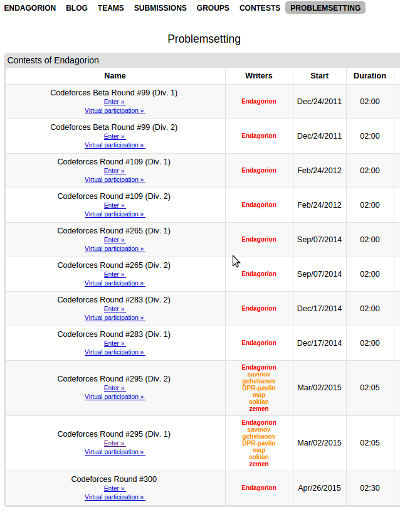Hi, Codeforces!
Codeforces Round #325 will take place on October 12, 2015 at 09:00 UTC for the first and second divisions. Please note that the round will start at unusual time!
The problems of this round are taken from the Regional stage of the All-Russian school team programming olympiad that will be at the same time in Saratov, Russia. Lets wish school teams good luck on competition!
The problemset for school olympiad differs from problems that will be on round. In addition in problemset for school olympiad there will be some problems, which are not included in the round and vice versa. So don't be frightened by the difficulty of problems given for school teams :-)
The process of problems preapring was very interesting: we were reworking problem statements many times, adding tests, changing limits, even managed to change fully prepared problem with another (we had to stop the conveyor already printing problem statements :-)) Let's thank all who were preparing, helping in preparing, reading the problem statements, writing solutions: Adilbek adedalic Dalabaev, Roman Roms Glazov, Vladimir vovuh Petrov, Oleg Oleg_Smirnov Smirnov, Alexey Perforator Ripinen, Maxim Neon Mescheryakov, Ilya IlyaLos Los, Vitaliy gridnevvvit Gridnev, Danil danilka.pro Sagunov, Alexander fcspartakm Frolov, Pavel HolkinPV Kholkin, Igor Igor_Kudryashov Kudryashov, Elena elena Rogacheva, Dmitriy Nerevar Matov, Vitaliy kuviman Kudasov. Chairman of the jury of the Olympiad is Mikhail MikeMirzayanov Mirzayanov (also he is the author of some of tasks). I (Edvard Edvard Davtyan) prepared some tasks and coordinated the work of the authors. So we are a large team of writers (I hope I did not forget anyone)!
Also let's thank Max Akhmedov (Zlobober), The-One-Who-Must-Not-Be-Named (if I am not wrong, he or she is right now solving the round problems) for their help in problems preparing, Maria Belova (Delinur) for translating problems in English and again Mikhail Mirzayanov (MikeMirzayanov) for the Codeforces and Polygon systems.
You will have only two hours to solve six problems. The scoring distribution will be anounced a little before the round. I wish high rating to all participants! Good luck and have fun!
P.S.: Also I want to wish good luck to the participants of the ACM ICPC Southern Subregional Programming Contest that will be held on Wednesday.
UPD Due to technical reasons round is delayed by 10 minutes.
UPD: In problem Subway roller there were tests with trains of length one. At this moment authors are discussing how much it troubled the round results. We are apologize to participants who had problems with that. We will announce our decision about this problem soon.
UPD2: There were trains with length equal to one in tests for problem Subway Roller. Jury decided to accept the first right solution of each user that passed all tests except the wrong, also other submissions were ignored. In addition we accept all successed hacks, although the hack is not correct and the hacked solution passed all other tests. Contest will be rated, but any user who think that this situation is cardinally affected to his/her result can send me in 24 hours a message and jury will discuss the question to make round unrated only for that participant. We are apologize to participants one more time for this situation.
UPD3: Editorial









 used on Codeforces.
used on Codeforces. .
. (
( ), or are important both factors, not just the value of the product (in expressions of type field
), or are important both factors, not just the value of the product (in expressions of type field  ), use the symbol
), use the symbol  (
( (
( (
( (
( (
( (
( =
=  =
=  =
=  =
=  =
=  =
= 

